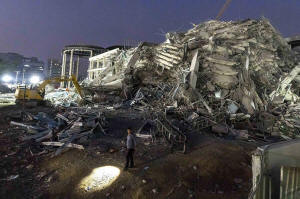Myanmar's earthquake death toll jumps to more than 1,000 as more bodies
recovered from the rubble
[March 29, 2025]
By DAVID RISING and JINTAMAS SAKSORNCHAI
BANGKOK (AP) — The death toll from a powerful 7.7 magnitude earthquake
in Myanmar jumped to more than 1,000 on Saturday as more bodies were
pulled from the rubble of the scores of buildings that collapsed when it
struck near the country's second-largest city.
The country's military-led government said in a statement that 1,002
people have now been found dead and another 2,376 injured, with 30
others missing. The statement suggested the numbers could still rise,
saying “detailed figures are still being collected.”
Myanmar, also known as Burma, is in the throes of a prolonged and bloody
civil war, which is already responsible for a massive humanitarian
crisis. It makes movement around the country both difficult and
dangerous, complicating relief efforts and raising fears that the death
toll could still rise precipitously.
The earthquake struck midday Friday with an epicenter not far from
Mandalay, followed by several aftershocks including one measuring a
strong 6.4 magnitude. It sent buildings in many areas toppling to the
ground, buckled roads, caused bridges to collapse and burst a dam.
In the capital Naypyidaw, crews worked Saturday to repair damaged roads,
while electricity, phone and internet services remained down for most of
the city. The earthquake brought down many buildings, including multiple
units that housed government civil servants, but that section of the
city was blocked off by authorities on Saturday.
More damage in Thailand
In neighboring Thailand, the quake rocked the greater Bangkok area, home
to some 17 million people, and other parts of the country.

Bangkok city authorities said so far six people have been found dead, 26
injured and 47 are still missing, most from a construction site near the
capital's popular Chatuchak market.
On Saturday, more heavy equipment was brought in to move the tons of
rubble, but hope was fading among friends and family members of the
missing that they would be found alive.
“I was praying that that they had survived but when I got here and saw
the ruin — where could they be? In which corner? Are they still alive? I
am still praying that all six are alive,” said 45-year-old Naruemol
Thonglek, sobbing as she awaited news about her partner, who is from
Myanmar, and five friends who worked at the site.
“I cannot accept this. When I see this I can’t accept this. A close
friend of mine is in there, too,” she said.
Waenphet Panta said she hadn't heard from her daughter Kanlayanee since
a phone call about an hour before the quake. A friend told her
Kanlayanee had been working high on the building on Friday.
“I am praying my daughter is safe, that she has survived and that she’s
at the hospital,” she said, Kanlayanee’s father sitting beside her.
Thai authorities said that the quake and aftershocks were felt in most
of the country's provinces. Many places in the north reported damage to
residential buildings, hospitals and temples, including in Chiang Mai,
but the only casualties were reported in Bangkok
Myanmar sits on a major fault line
Earthquakes are rare in Bangkok, but relatively common in Myanmar. The
country sits on the Sagaing Fault, a major north-south fault that
separates the India plate and the Sunda plate.

Brian Baptie, a seismologist with the British Geological Survey, said it
appears a 200-kilometer (125-mile) section of the fault ruptured for
just over a minute, with a slip of up to 5 meters (16.4 feet) in places,
causing intense ground shaking in an area where most of the population
lives in buildings constructed of timber and unreinforced brick masonry.
“When you have a large earthquake in an area where there are over a
million people, many of them living in vulnerable buildings, the
consequences can often be disastrous," he said in a statement.
“From initial reports, that seems likely to be the case here.”
[to top of second column]
|

Rescuers search for victims at the site of a high-rise building
under construction that collapsed after a strong earthquake in
Bangkok, Thailand, early Saturday, March 29, 2025. (AP Photo/Wason
Wanichakorn)

A natural disaster on top of a civil war
Myanmar’s government said blood was in high demand in the
hardest-hit areas. In a country where prior governments sometimes
have been slow to accept foreign aid, Min Aung Hlaing said Myanmar
was ready to accept outside assistance.
Myanmar’s military seized power from the elected government of Aung
San Suu Kyi in February 2021, and is now involved in a bloody civil
war with long-established militias and newly formed pro-democracy
ones.
Military forces continued their attacks even after the quake, with
three airstrikes in northern Kayin state, also called Karenni state,
and southern Shan — both of which border Mandalay state, said Dave
Eubank, a former U.S. Special Forces soldier who founded the Free
Burma Rangers, a humanitarian aid organization that has provided
assistance to both combatants and civilians in Myanmar since the
1990s.
Eubank told The Associated Press that in the area he was operating
in, most villages have already been destroyed by the military so the
earthquake had little impact.
“People are in the jungle and I was out in the jungle when the
earthquake hit — it was powerful, but the trees just moved, that was
it for us, so we haven't had a direct impact other than that the
Burma army keeps attacking, even after the quake,” he said.
In northern Shan, an airstrike on a rebel-controlled village just
minutes after the earthquake killed seven militia members and
damaged five buildings, including a school, Mai Rukow, editor of a
Shan-based online media Shwe Phee Myay News Agency, told the AP.
Government forces have lost control of much of Myanmar, and many
places are incredibly dangerous or simply impossible for aid groups
to reach. More than 3 million people have been displaced by the
fighting and nearly 20 million are in need, according to the United
Nations.

“Although a full picture of the damage is still emerging, most of us
have never seen such destruction," said Haider Yaqub, Myanmar
country director for the NGO Plan International, from Yangon.
“Without a doubt, the humanitarian needs will be significant.”
Rescue groups head to Myanmar
China and Russia are the largest suppliers of weapons to Myanmar's
military, and were among the first to step in with humanitarian aid.
China said it has sent more than 135 rescue personnel and experts
along with supplies like medical kits and generators, and pledged
some $13.8 million in emergency humanitarian aid. Russia’s
Emergencies Ministry said it had flown in 120 rescuers and supplies.
India also sent a search and rescue team and a medical team and
Malaysia said it would send 50 people on Sunday.
South Korea said it would provide $2 million worth of humanitarian
aid through international organizations, and the U.N. allocated $5
million to start relief efforts.
President Donald Trump said Friday that the U.S. was going to help
with the response, but some experts were concerned about this effort
given his administration’s deep cuts in foreign assistance.
___
AP writers Jerry Harmer and Grant Peck in Bangkok, Simina Mistreanu
in Taipei and Tong-hyung Kim in Seoul, South Korea, contributed to
this report.
All contents © copyright 2025 Associated Press. All rights reserved |